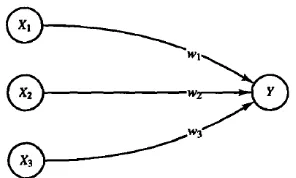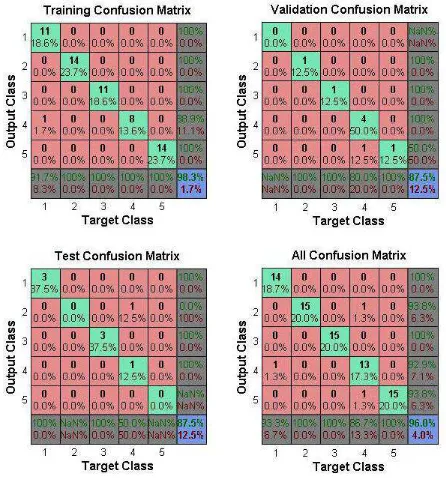a
Corresponding author: [email protected]
Speech Recognizing for Presentation Tool Navigation Using Back
Propagation Artificial Neural Network
Nur Hasanaha, Dessy Irmawati, Fatchul Arifinand Eko Marpanaji
Electronics Engineering Education Department, Yogyakarta State University, Karangmalang, Yogyakarta 55281, Indonesia
Abstract. Backpropagation Artificial Neural Network (ANN) is a well known branch of Artificial Intelligence and has been proven to solve various problems of complex speech recognizing in health [1], [2], education [4] and engineering [3]. Today, many kinds of presentation tools are used by society. One popular example is MsPowerpoint. The transition process between slides in presentation tools will be more easily done through speech, the sound emitted directly by the user during the presentation. This study uses research and development to create a simulation using Backpropagation ANN for speech recognition from number one to five to navigate slides of the presentation tool. The Backpropagation ANN consists of one input layer, one hidden layer with 100 neurons and one output layer. The simulation is built by using a Neural Network Toolbox Matlab R2014a. Speech samples were taken from five different people with wav format. This research shows that the Backpropagation ANN can be used as navigation through speech with 96% accuracy rate based on the network training result. Thesimulation can produce 63% accuracy based on 100 new speech samples from various sources.
1 Background
Artificial Neural Network (ANN) is a branch of Artificial Intelligence which has been widely applied to various applications and is proven to solve various complex problems. Backpropagation is one of the popular ANN architecture and is widely applied in research of speech recognizing, for example, speech recognition of a recently born baby [1], speech recognition of cardiac abnormalities [2], speech recognition to control robots [3] and speech recognition to learn foreign language [4].
Presentation tools usually consists of slides that can be displayed on the screen and the user can navigate using a keyboard or other controller devices such as mouse, wireless mouse and wireless pointer. The control device intended to facilitate users in giving presentations. But the use of a keyboard and mouse in the transition between slides still limit the movement of user because there is a maximum distance between the devices with a laptop or computer that is used. While wireless pointer provides only know next and previous orders and can not refer directly to a specific slide the user wants. The transition process between slides will be more easily done through speech, the sound emitted directly by the user during the presentation. The easier use of the device, the better support for the presentation process. Therefore, this research aims to create software for presentation tool navigation through speech, using Backpropagation ANN.
2 Theoretical basis
2.1 Fast fourier transform algorithm
FFT is a method for transforming the speech signal into a
frequency signal, meaning that the speech recording is recorded in digital form in the form of wave-based speech frequency spectrum. The FFT algorithm is designed to perform complex multiplications and additions, even though the input data may be real valued [5].
2.2 Artificial neural network
An artificial neural network is an information-processing system that has certain performance characteristics in common with biological neural networks. Artificial neural networks have been developed as generalizations of mathematical models of human cognition or neural biology [6].
Figure 1. A simple (artificial) neuron.
Each neuron has an internal state, called its activation or activity level, which is a function of the inputs it has received. Typically, a neuron sends its activation as a signal to several other neurons. For example, consider a neuron Y, illustrated in Figure 1, that receives inputs from neurons X1, X2, and X3. The activations (output
2.3 Common activation functions
1. Identity function (Purelin)
f (x) = x , for all x (2)
Single-layer nets often use a step function to convert the net input, which is a continuously valued variable, to an output unit that is a binary (1 or 0) or bipolar (1 or -1) signal [6].
Figure 2. Identity function.
2. Binary Sigmoid function (Logsig)
() = 1
1 + exp(−)
′() = ()[1 − ()] (3)
During feedforward, each input unit (Xi) receives an input signal and broadcasts this signal to the each of the
hidden units Z1, … , Zp. Each hidden unit then computes its activation and sends its signal (zj) to each output unit.
Each output unit (Yk) computes its activation (yk) to form the response of the net for the given input pattern [6].
Figure 3. Binary Sigmoid. Stepness parameters a = 1 and a = 3
Figure 4. BipolarSigmoid.
Figure 5. Backpropagation ANN with one hidden layer.
During training, each output unit compares its computed activation yk with its target value tk to determine the associated error for that pattern with that unit. Based on this error, the factor k( k = 1, … m) is computed. kis used to distribute the error at output unit
k
Y back to all units in the previous layer (the hidden units that are connected to Yk). It also used (later) to update the weights between the output layer and the hidden layer.
After all of the δ factors have been determined, the weights for all layers are adjusted simultaneously. The adjustment to the weight wjk (from hidden unit Zj to
output unit Yk ) is based on the factor k and the
DOI: 10.1051/ 07001 (2016)
, matecconf/2016
MATEC Web of Conferences 7 7507001
ICMIE 2016
5
activation zj of the hidden unit Zj. The adjustment to the
weight vij (from input unit Xi to hidden unit Zj) is based
on the factor j and the activation xi of the input unit [6]. Backpropagation learning has emerged as the standard algorithm for the training of multilayer perceptrons, against which other learning algorithms are often bench-marked [7].
3 Research Method
This study uses Research and Development to develop speech recognition simulation of number one, two, three, four and five. Speech samples were taken from five
different people with wav format. The total of speech samples for network training is 75. Each number has 15 speech samples.
3.1. Feature extraction
In this stage, software for preprocessing is built using FFT, as shown in Figure 6.
3.2 Network training
The next stage is to design software and implement ANN
Backpropagation algorithms to learn speech patterns. Backpropagation ANN is an autoassociative network type, input range that is processed into the same network with the range of output results. Backpropagation ANN development in general can be seen in Figure 7.
Figure 6. Preprocessing stage.
Figure 7. Development process of artificial neural networks.
Thus, the general system of this application follows a path as shown in Figure 8.
The Backpropagation ANN consists of one input layer, one hidden layer and one output layer. Activation function is used to connect the input layer to the hidden layer and also to connect the hidden layer to the output layer. Activation function used in the research is Tansig. A multilayer network learns much faster when the sigmoidal activation function is represented by a hyperbolic tangent [8].
4 Result and discussion
The Backpropagation ANN built has 1 hidden layer with 100 neurons. The activation function used is Tansig. There are two ways to determine the training process stops, by limiting the number of iterations or Mean Square Error (MSE).
The simulation is built by using a Neural Network Toolbox Matlab R2014a. Matlab is an interactive, matrix-based system for scientific and engineering numeric computation and visualization. Its strength lies in the fact that complex numerical problems can be solved easily and in a fraction of the time required with a programming language. The basic Matlab program is further enhanced by the availability of numerous toolboxes [9].
In the simulation, the number of iterations is limited to 1000 while MSE is limited to 1.00e-06. Network training results can be seen in Figure 9. The training process occurs until 23 iteration and training time during 0 second.
While Figure 10 shows the results of Confusion. The conclusion obtained is the level of accuracy in determining the output network is 96 %.
To measure the accuracy of Backpropagation ANN, it is necessary to test some new speech samples using a simulation program that can be seen in Figure 11.
Figure 8. Flowchartof the simulationsystem.
Figure 9. Result of network training.
This program provides menus to recordspeech, play speech, save speech and open a speech that have been saved. After a speech has beenrecorded, the program will display the results in terms of numbers as well as opening the intendedslide presentation tool. The speech will be recorded by the internal microphone on the PC / laptop.
Figure 12 shows part of codes from Matlab program that instructs to go to the slide based on the analysis result from the speech input.
Figure 10.Result of confusion.
Figure 11. GUI of the simulation system.
hShow = s.SlideShowWindows.Item(1);
if y(1)==1
set(findobj('Tag','hasil'),'String','1');
set(findobj('Tag','nama'),'String',filename);
hShow.View.GotoSlide(1);
elseif y(2)==1
set(findobj('Tag','hasil'),'String','2');
set(findobj('Tag','nama'),'String',filename);
hShow.View.GotoSlide(2);
Figure 12. Matlab source codes for slide navigation.
In Figure 13, it can be seen that the program record a new speechsamplethen saved it as Sample_a2.wav. This speech instruction is to open the slide 2. It can be seen that the program succeeded in opening the slide 2.
Figure 13. Testing new speech sample inopening slide 2.
While in Figure 14, it can be seen that the program record another new speechsample then saved it as Sample_a3.wav. This speech instruction to open the slide 3. This speech instruction is to open the slide 3. It can be seen that the program succeeded in opening the slide 3.
DOI: 10.1051/ 07001 (2016)
, matecconf/2016
MATEC Web of Conferences 7 7507001
ICMIE 2016
5
Figure 14. Testing new speech sample in opening slide 3.
The new speech samples tested were 100 speeches from different sources. Some results of the testing can be seen in Table 1.
The result showsthat the simulation can
recognize63speeches correctly and can demonstrate the proper slide. While 37speeches can not be recognized properly by the system and showed wrong slides.
Table 1. Result of new speech samples
No File Name Purposed
Slide
Slide Result Corr ect
Based on test results and discussion, it can be concluded that the Backpropagation ANN can be used as a
presentation tool navigation through speech with 96% accuracy rate based on the network training result. The simulation can produce 63% accuracy based on 100 new speech samples from various sources.
References
1. R. Orion F. and R. Carlos Alberto, SPECOM 9th Conference Speech and Computer, A System for the Processing of Infant Cry to Recognize Pathologies in Recently Born Babies with Neural Network (2004) 2. Asian Network for Scientific Information,
Classification of Heart Abnormalities Using Artificial Neural Network, 820–821 (2007)
3. W. Suryo. and Thiang, IPCSIT, Speech Recognition Using Linear Predictive Coding and Artificial Neural Network for Controlling Movement of Mobile Robot, 6 (2011)
4. V. Radha, Vimala C. and M. Krishnaveni, CSEIJ,Isolated Word Recognition System for Tamil Spoken Languange Using Backpropagation Neural Network Based on LPCC Features, 1(2011)
5. P. John G. And M. Dimitris G, Digital Signal Processing Priciples, Algorithms, and Applications Third Edition. Prentice Hall International Edition (1996)
6. F. Lauren, Fundamental of Neural Network. Prentice Hall International Edition (1994)
7. H. Simon, Neural Network A Comprehensive Foundation. Prentice Hall International Edition (1999).
8. N. Michael, Artificial Intelligence: A Guide to Intelligent Systems, Pearson Education (2002)



